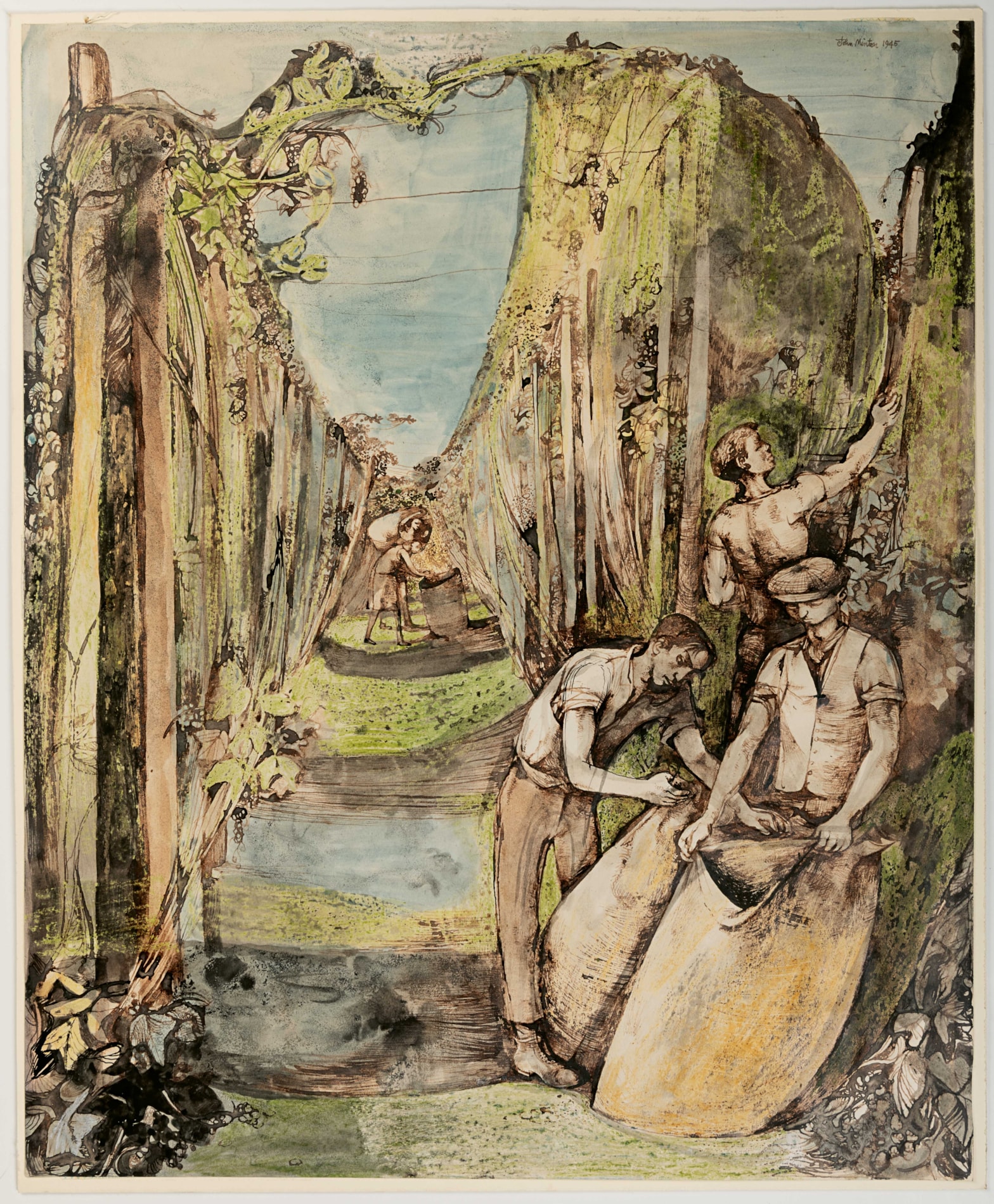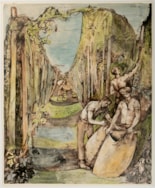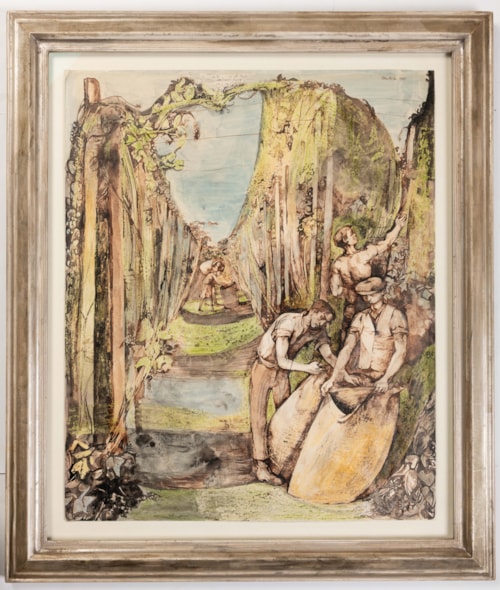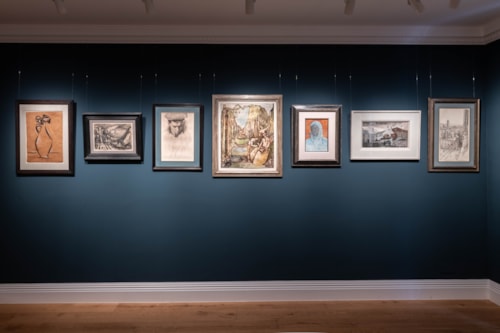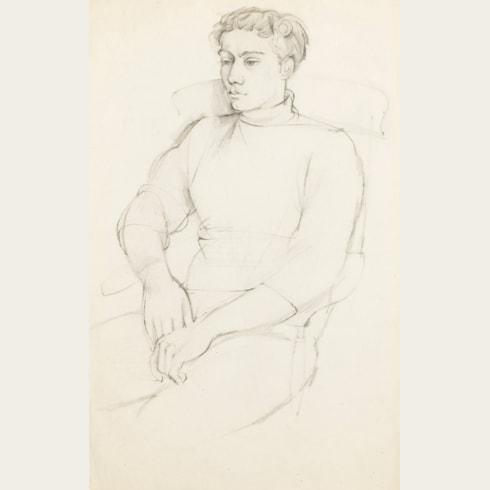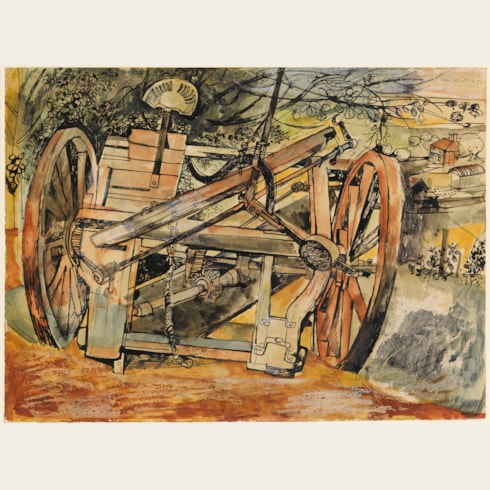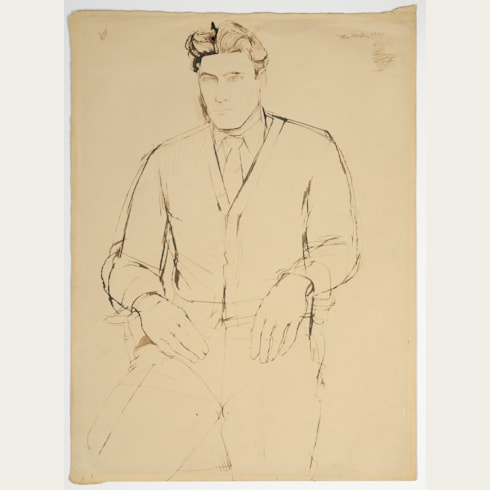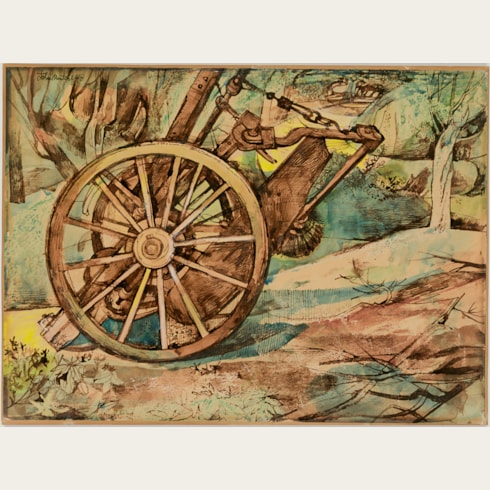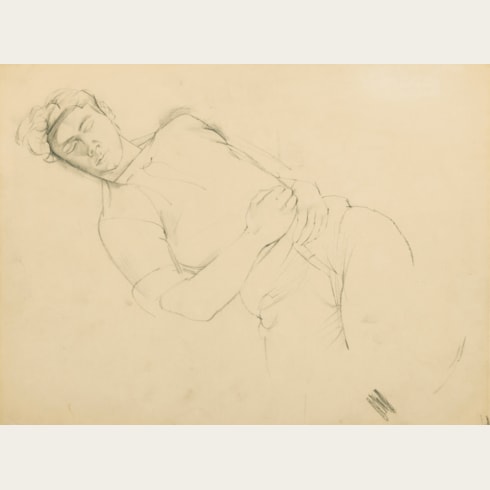John MINTON
(Great Shelford 1917 - London 1957)
The Hop Pickers, Kent
Pen and brown ink and brown wash, pencil and watercolour.
Signed and dated John Minton 1945 at the upper right.
635 x 520 mm. (25 x 20 1/2 in.)
Signed and dated John Minton 1945 at the upper right.
635 x 520 mm. (25 x 20 1/2 in.)
John Minton’s interest in landscape painting took root in the early 1940s, during his military service. As he wrote to one friend in September 1942, ‘More and more landscape interests me’, while to the artist Michael Ayrton a few months later he noted that working on landscape subjects was ‘more straightforward and direct a thing than the tenacious line of neo-romanticism: I feel happier finally in the English tradition.’ As Frances Spalding has noted of Minton, ‘He never entirely abandoned his neo-romantic style, but as his career developed and he began to work more as an illustrator, he kept a sweeter version of it for landscape subjects. In his many drawings of the Kent countryside he continued to reflect upon the romantic landscape tradition, bringing to it his superb control of the medium of pen and ink.’
Executed in 1945, this large and impressive sheet is a superb example of Minton’s landscape drawing at the height of its power. The artist here depicts a group of farm labourers harvesting hops in the autumn, creating a Romantic vision of the Kent landscape and the activities of the local people. The present sheet was executed during a period when Minton often visited ‘Marshalls’, the home of his friends Edie and Newton Lamont in the village of Chart Sutton in Kent. Minton had met Edie Lamont in the 1930s when both were students at the St. John’s Wood Art School, and they remained good friends for many years afterward. Between 1945 and 1954 Minton would occasionally escape London to stay with the Lamonts at ‘Marshalls’, with its view over the Weald of Kent, and make sketching trips with Edie around the countryside, at places such as Forstall, Frittenden, Little Chart and Tenterden.
As Spalding recounts, ‘From [Edie’s] diaries we know that Minton made between two and four visits to ‘Marshalls’ every year up until 1954, staying usually a couple of nights and returning to London with sheaves of drawings…His Kent landscapes had contributed significantly to the success of his 1945 Rowland, Browse and Delbanco exhibition, soon after which he tried to interest the same gallery in Edie Lamont’s work…Minton’s friends were aware that Edie Lamont was an important figure in Minton’s life, but most knew little or nothing about her. He deliberately kept the Lamonts in a separate compartment, their home providing him with a place to refuel in company he enjoyed and in countryside he loved.’ On one of Minton’s visits to ‘Marshalls’, in December 1946, he was accompanied by his friend and fellow artist Keith Vaughan.
The present sheet was almost certainly among a number of Minton’s Kent drawings that were included, the same year it was drawn, in an exhibition at the newly-opened Rowland, Browse and Delbanco Gallery in London. As Spalding writes, ‘Meanwhile [Minton’s] landscape drawings had become much sought after. He held two one-man exhibitions in 1945: one in the top floor gallery at the recently opened Roland, Browse and Delbanco of drawings of Kent and Cornwall; the other at the Lefevre Gallery. Both shows sold well, Minton’s drawings at this time fetching between ten and twenty guineas.’ This drawing was later reproduced, with the caption ‘In the Country: Hop Picking near Maidstone, Kent’, as one of eight colour plates in George Orwell’s The English People (1947), part of the Britain in Pictures series of books published between 1941 and 1950 and intended to boost morale during the war years.
A much smaller and less finished variant of this composition, of horizontal format and focussing on the three main figures, appeared at auction in London in 2010 and is today in the Ingram Collection in London. A related work, of horizontal format and depicting three female hop pickers seated in a field and separating bunches of hops, was in a private collection in Ireland and recently appeared at auction in London.
Executed in 1945, this large and impressive sheet is a superb example of Minton’s landscape drawing at the height of its power. The artist here depicts a group of farm labourers harvesting hops in the autumn, creating a Romantic vision of the Kent landscape and the activities of the local people. The present sheet was executed during a period when Minton often visited ‘Marshalls’, the home of his friends Edie and Newton Lamont in the village of Chart Sutton in Kent. Minton had met Edie Lamont in the 1930s when both were students at the St. John’s Wood Art School, and they remained good friends for many years afterward. Between 1945 and 1954 Minton would occasionally escape London to stay with the Lamonts at ‘Marshalls’, with its view over the Weald of Kent, and make sketching trips with Edie around the countryside, at places such as Forstall, Frittenden, Little Chart and Tenterden.
As Spalding recounts, ‘From [Edie’s] diaries we know that Minton made between two and four visits to ‘Marshalls’ every year up until 1954, staying usually a couple of nights and returning to London with sheaves of drawings…His Kent landscapes had contributed significantly to the success of his 1945 Rowland, Browse and Delbanco exhibition, soon after which he tried to interest the same gallery in Edie Lamont’s work…Minton’s friends were aware that Edie Lamont was an important figure in Minton’s life, but most knew little or nothing about her. He deliberately kept the Lamonts in a separate compartment, their home providing him with a place to refuel in company he enjoyed and in countryside he loved.’ On one of Minton’s visits to ‘Marshalls’, in December 1946, he was accompanied by his friend and fellow artist Keith Vaughan.
The present sheet was almost certainly among a number of Minton’s Kent drawings that were included, the same year it was drawn, in an exhibition at the newly-opened Rowland, Browse and Delbanco Gallery in London. As Spalding writes, ‘Meanwhile [Minton’s] landscape drawings had become much sought after. He held two one-man exhibitions in 1945: one in the top floor gallery at the recently opened Roland, Browse and Delbanco of drawings of Kent and Cornwall; the other at the Lefevre Gallery. Both shows sold well, Minton’s drawings at this time fetching between ten and twenty guineas.’ This drawing was later reproduced, with the caption ‘In the Country: Hop Picking near Maidstone, Kent’, as one of eight colour plates in George Orwell’s The English People (1947), part of the Britain in Pictures series of books published between 1941 and 1950 and intended to boost morale during the war years.
A much smaller and less finished variant of this composition, of horizontal format and focussing on the three main figures, appeared at auction in London in 2010 and is today in the Ingram Collection in London. A related work, of horizontal format and depicting three female hop pickers seated in a field and separating bunches of hops, was in a private collection in Ireland and recently appeared at auction in London.
Although he had only a relatively brief career before his death at the age of thirty-nine, John Minton was enormously prolific and achieved a great deal of success in his lifetime. Between 1945 and 1956 he had eight one-man shows, mainly at the Lefevre Gallery in London, as well as taking part in a number of group shows and the Royal Academy Summer exhibitions. Alongside his output as a painter and draughtsman, he provided numerous illustrations for books, book jackets, magazines and advertisements, and also designed posters, wallpaper and stage sets.
While he enjoyed considerable early success, by the 1950’s Minton’s work was becoming overshadowed by that of other artists in his circle, notably Lucian Freud and Francis Bacon. As a friend of his later wrote, ‘He saw himself as overtaken by fashions in art – abstract expressionism among others – for which he had no liking. While others of his contemporaries – Lucien Freud, Francis Bacon, Keith Vaughan - held their ground and came through, Minton saw himself as obsolete, as eccentric and old-fashioned as Edward Lear. He could not come to terms with new developments and he lost faith in his own talent…He was, I suppose, one of those kingfisher-like specimens whose bright plumage briefly glinted then was gone. It might, perhaps, have been different in other circumstances; a little more patience and he could have survived the disorienting shifts in taste.’
Minton devoted much of his later career to teaching, in particular at the Royal College of Art, and was a popular and inspirational figure among his students. As Frances Spalding has written of him, ‘Minton’s virtuoso performances with pencil or pen and ink commended him as a teacher. His students aspired to his dexterity and adopted his devices.’ Minton died, by his own hand, in January 1957.
Provenance
Rowland, Browse & Delbanco, London, in 1945
The Fine Art Society, London, in 1984-1985
Acquired from them by Alexander Andrew ‘Derry’ Irvine, Baron Irvine of Lairg.
The Fine Art Society, London, in 1984-1985
Acquired from them by Alexander Andrew ‘Derry’ Irvine, Baron Irvine of Lairg.
Literature
George Orwell, The English People, London, 1947, illustrated in colour between pp.8 and 9 (as ‘Hop Picking near Maidstone, Kent’); Frances Spalding, John Minton: Dance till the Stars Come Down, Aldershot, 1991 [2005 ed.], illustrated in colour pl.IV.
Exhibition
Rowland, Browse & Delbanco, London, in 1945; London, The Fine Art Society, Spring ’85, 1985, no.29.

